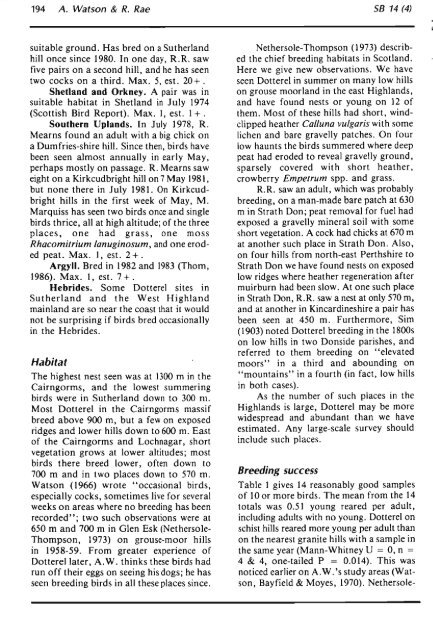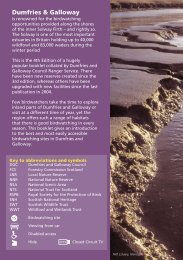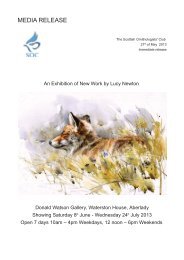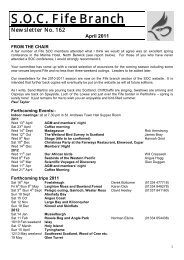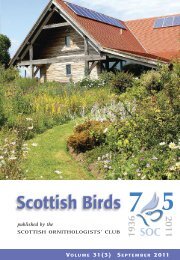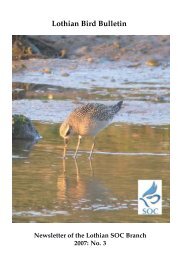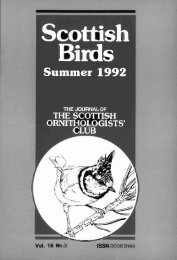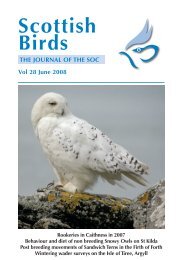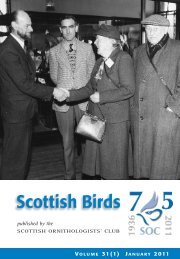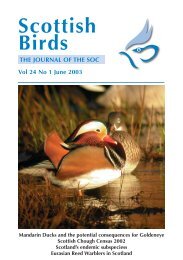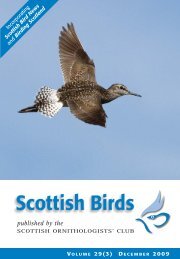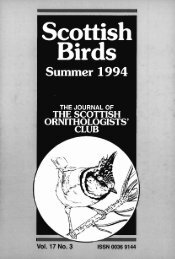V 14 No.4 - The Scottish Ornithologists' Club
V 14 No.4 - The Scottish Ornithologists' Club
V 14 No.4 - The Scottish Ornithologists' Club
Create successful ePaper yourself
Turn your PDF publications into a flip-book with our unique Google optimized e-Paper software.
194 A. Watson & R. Rae<br />
S8 <strong>14</strong> (4)<br />
suitable ground. Has bred on a Sutherland<br />
hill once since 1980. In one day, R.R. saw<br />
five pairs on a second hill, and he has seen<br />
two cocks on a third. Max. 5, est. 20+ .<br />
Shetland and Orkney. A pair was in<br />
suitable habitat in Shetland in July 1974<br />
(<strong>Scottish</strong> Bird Report). Max. I, est. 1+.<br />
Southern Uplands. In July 1978, R.<br />
Mearns found an adult with a big chick on<br />
a Dumfries-shire hill. Since then, birds have<br />
been seen almost annually in early May,<br />
perhaps mostly on passage. R. Mearns saw<br />
eight on a Kirkcudbright hill on 7 May 1981,<br />
but none there in July 1981. On Kirkcudbright<br />
hills in the first week of May, M.<br />
Marquiss has seen two birds once and single<br />
birds thrice, all at high altitude; of the three<br />
places, one had grass, one moss<br />
Rhacomitrium lanuginosum, and one eroded<br />
peat. Max. I, est. 2 + .<br />
Argyll. Bred in 1982 and 1983 (Thorn,<br />
1986). Max. 1, est. 7+.<br />
Hebrides. Some Dotterel sites in<br />
Sutherland and the West Highland<br />
mainland are so near the coast that it would<br />
not be surprising if birds bred occasionally<br />
in the Hebrides.<br />
Habitat<br />
<strong>The</strong> highest nest seen was at 1300 m in the<br />
Cairngorms, and the lowest summering<br />
birds were in Sutherland down to 300 m.<br />
Most Dotterel in the Cairngorms massif<br />
breed above 900 m, but a few on exposed<br />
ridges and lower hills down to 600 m. East<br />
of the Cairngorms and Lochnagar, short<br />
vegetation grows at lower altitudes; most<br />
birds there breed lower, often down to<br />
700 m and in two places down to 570 m.<br />
Watson (1966) wrote "occasional birds,<br />
especially cocks, sometimes live for several<br />
weeks on areas where no breeding has been<br />
recorded"; two such observations were at<br />
650 m and 700 m in Glen Esk (Nethersole<br />
Thompson, 1973) on grouse-moor hills<br />
in 1958-59. From greater experience of<br />
Dotterel later , A. W. thinks these birds had<br />
run off their eggs on seeing his dogs; he has<br />
seen breeding birds in all these places since.<br />
Nethersole-Thompson (1973) described<br />
the chief breeding habitats in Scotland.<br />
Here we give new observations. We have<br />
seen Dotterel in summer on many low hills<br />
on grouse moorland in the east Highlands,<br />
and have found nests or young on 12 of<br />
them. Most of these hills had short, windclipped<br />
heather Col/una vulgaris with some<br />
lichen and bare gravelly patches. On four<br />
low haunts the birds summered where deep<br />
peat had eroded to reveal gravelly ground,<br />
sparsely covered with short heather,<br />
crow berry Empetrum spp. and grass.<br />
R.R. saw an adult, which was probably<br />
breeding, on a man-made bare patch at 630<br />
m in Strath Don; peat removal for fuel had<br />
exposed a gravelly mineral soil with some<br />
short vegetation. A cock had chicks at 670 m<br />
at another such place in Strath Don. Also,<br />
on four hills from north-east Perth shire to<br />
Strath Don we have found nests on exposed<br />
low ridges where heather regeneration after<br />
muirburn had been slow. At one such place<br />
in Strath Don, R.R. saw a nest at only 570 m,<br />
and at another in Kincardineshire a pair has<br />
been seen at 450 m. Furthermore, Sim<br />
(1903) noted Dotterel breeding in the 1800s<br />
on low hills in two Donside parishes, and<br />
referred to them breeding on "elevated<br />
moors" in a third and abounding on<br />
"mountains" in a fourth (in fact, low hills<br />
in both cases).<br />
As the number of such places in the<br />
Highlands is large, Dotterel may be more<br />
widespread and abundant than we have<br />
estimated. Any large-scale survey should<br />
include such places.<br />
Breeding success<br />
Table I gives <strong>14</strong> reasonably good samples<br />
of 10 or more birds. <strong>The</strong> mean from the <strong>14</strong><br />
totals was 0.51 young reared per adult,<br />
including adults with no young. Dotterel on<br />
schist hills reared more young per adult than<br />
on the nearest granite hills with a sample in<br />
the same year (Mann-Whitney U = 0, n =<br />
4 & 4, one-tailed P = 0.0<strong>14</strong>). This was<br />
noticed earlier on A.W.'s study areas (Watson,<br />
Bayfield & Moyes, 1970). Nethersole-


